May 12, 2010
High/Sticky Unemployment for Years to Come?
Is Full Employment No Longer A Realistic Goal for this Decade?
As the financial system of the European Union faces a meltdown from sovereign risk of nations like Greece and Portugal, pressure mounts on the Obama Administration to reduce the hemorrhaging from deficit spending whether from bailouts or expansion of the health care system. Rioting in Greece is daily fare of television, as the Greek Government implements austerity measures to restore budgetary sanity.
The ratio of federal government debt to GDP in the U.S. is approaching 100% and ranks up there with Greece and some other nations of the EU. Since the GDP of the U.S. ($14,185 billion) was around 87% of the entire EU ($16,264 billion) in 2009, U.S. woes pose a much more serious problem for the world financial markets than does the financial calamity in Greece, which is about the size of the State of Michigan GDP–wise but slightly larger population–wise. Remember that if California were an independent nation it would be the 8th largest in the World, GDP–wise.
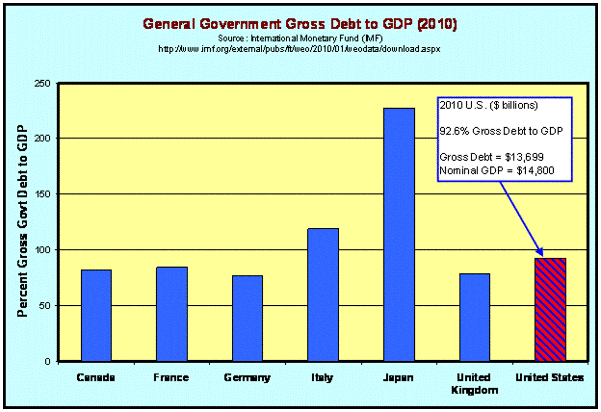
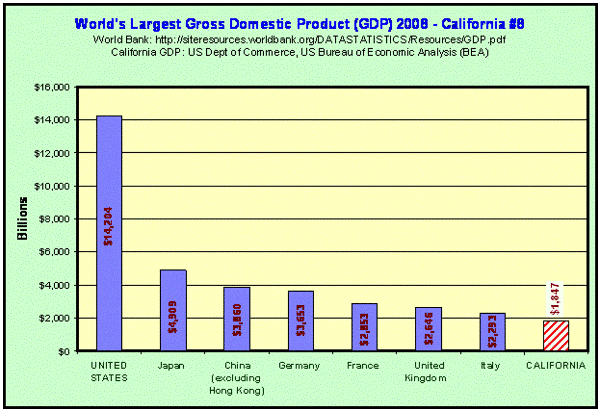
The Federal Reserve System (hereafter referred to as the FED) has expanded the monetary base enormously and cannot continue its all things to all people mentality. The third blog in this series of four will examine this dilemma.
Under the "guidance" of the Obama administration, Congress has legislated enormous deficits that have continued the trend started in the last days of the Bush II Administration. As the financial crises of Greece and the EU in general have shown, this cannot continue. Tax increases slow economic growth and the tax base as a result. The Rubinomics policies under Clinton should be a warning that a crash like that of 2000 (not 2001) awaits significant tax rate increases.
(The Financial Fiasco of Two–Thousand Eight (FFTTE))
www.econnewsletter.com/jan022009
12) The New Paradigm and the sparks that ignited the powder keg
This means that monetary and fiscal policies based upon the old model of demand side macroeconomics is at best of little value and at worst it can result in harmful macroeconomic policy effects. This happened in 1998–99 when the FED adopted a policy of monetary constraint and aggravated an economy that was already stressed by rising federal government surpluses due to several years of tax rate increases often referred to as Rubinomics (http://en.wikipedia.org/wiki/Rubinomics), after one of the Secretaries of the Treasury who convinced Congress of the wisdom of such a policy.
The fourth blog in this series will probe this restraint on future economic policies the likelihood that the U.S. can restore Full Employment in this decade.
With this in mind we now will examine the likelihood of returning to a full employment unemployment rate of 8%, or 5%, take your pick.
Keep in mind that the typical job growth over the last several years has been closer to 100,000 jobs per month than 200,000 jobs per month.
Unemployment dropping to 8% over the next 72 months (six–years)

Unemployment dropping to 5% over the next 72 months (six–years)
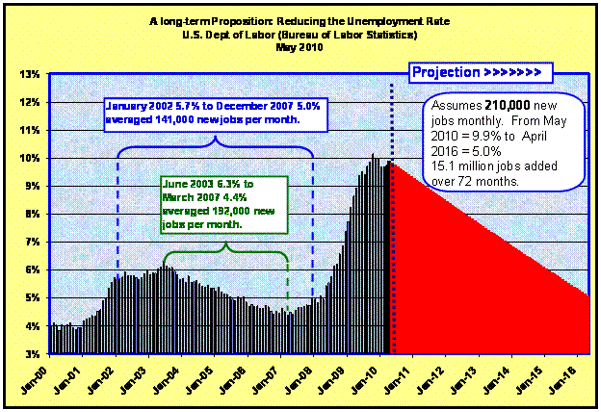
The current unemployment rate (May 2010) is now close to 10% as the latest report shows it has increased to 9.9%. In terms of unemployed, that is 15.3 million persons looking for jobs. As the talk of recovery surfaces in the media, the encouraged worker effect kicks in. These are persons who were laid off during the recession and stopped looking for work. They constitute the discouraged worker effect. In the Population or Household Survey conducted by the Census "Bureau, you are not included in the labor force unless you are employed or unemployed but looking for work.
For a look at a more thorough treatment on employment, going back to 2004, please take a look at our previous newsletter discussing the various issues and differences in the Population and Establishment Surveys
www.econnewsletter.com/mar292004
As new entrants to the labor force increase, they will also swell the number of unemployed even as the number of newly employed or re–employed increases.
1st cut: Working age population
2nd cut: Civilian Labor Force (those employed and unemployed seeking work)

Labor Force Participation Rate
(Civilian Labor Force / Civilian Noninstitutional Population)
The Labor Force Participation rate has been in the 66.0% range for the past several years prior to the end of 2008.
3rd cut: Employed from the Current Population Survey (CPS) aka, Household Survey
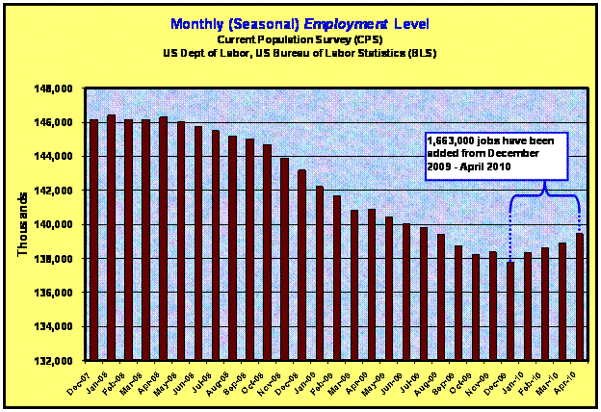
The rising employment numbers are mostly offset by an increasing numbers moving into the Labor Force: the 1,656,000 increase in Labor Force from December 2009 through April 2010 basically offset the 1,663,000 gains in employment.
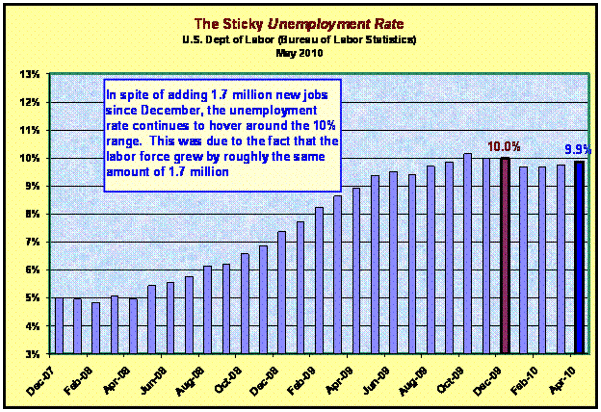
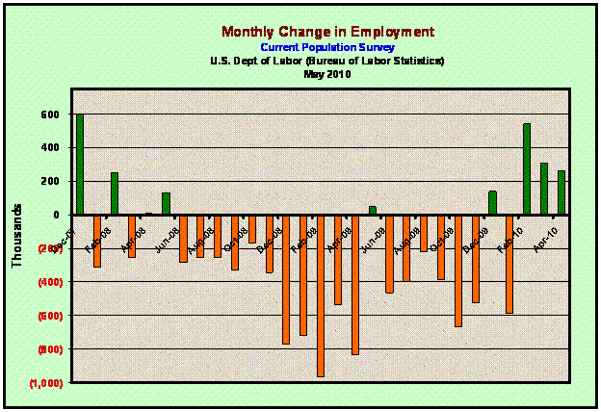
3rd & ½ cut: Employed from the Current Employment Statistics (CES) aka, Payroll or Establishment Survey
The data from the CES, and its more inclusive counterpart the CPS, show that the employment numbers are on the rise. Digging a bit deeper, we see that the CPS shows job growth of 1,663,000 between December 2009 and April 2010. The CES, on the other hand, shows an increase of 573,000. What this means is that more than a million of the jobs added since December 2009 have come from the non–CES portion of the CPS. More specifically, this points to significant job growth outside of the realm of the traditional/payroll firms; instead, this points to growth in the small business, self–employed end of the employment spectrum.
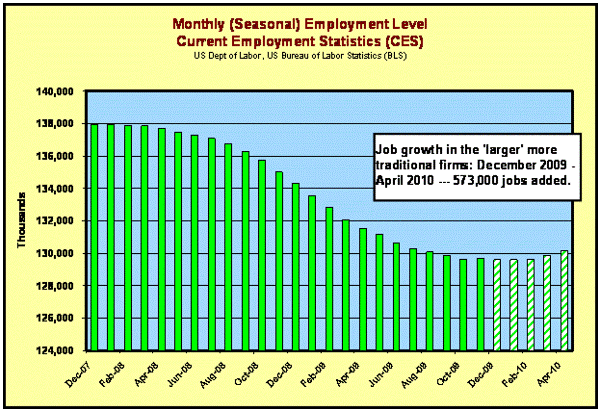
Summing it up…
The likelihood of the U.S. economy returning to a 'full employment' unemployment rate of 5% by April of 2016 is virtually zero. It would take nearly 6 years of monthly new job creation of 210,000 to achieve that goal. This rapid job growth rate has no recent historical precedent.
The next two blogs in this series will point out the constraints on monetary and fiscal policies needed to make such a rapid job growth rate possible. In the recovery beginning in late 2001, the unemployment rate was much lower to begin with. This current recovery began with an unemployment rate close to 10%. As the encouraged worker effect kicks in and as population growth above 16 years of age is factored in, traditional job growth rates do little more than maintain the status quo as regards the unemployment rate.
The more likely scenario is that by April of 2016 the unemployment rate is more likely to be in the 7 to 8% range, assuming no new crises arise in the national and international financial systems. This is not a certainty as many think the fundamental changes needed to avoid another financial fiasco have not been made and perhaps not even fully understood.
Looming tax increases to attempt to eliminate enormous projected federal budgetary deficits, portend a very slow recovery and sub–par job growth rates. These dismal policy outlooks will be covered more deeply in the remaining blogs of this four part series.
It will take ten years, that is, until 2020 to reach the 5% unemployment rate, with an employment growth of around 150,000. This assumes a monthly average noninstitutional civilian population growth of around 83,000; a civilian labor force growth of 90,000 monthly; all of which drives the labor force participation rate from its current (April 2010) 65.2 to (April 2020) 67.0%.
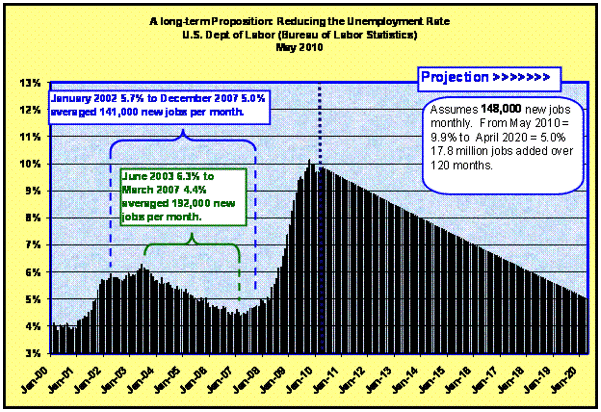
1) FYI – Unemployment Duration (latest numbers: long–term continuing to rise)

2) FYI – Underemployment

From U.S. Bureau of Labor Statistics (BLS)
NOTE: Persons marginally attached to the labor force are those who currently are neither working nor looking for work but indicate that they want and are available for a job and have looked for work sometime in the past 12 months. Discouraged workers, a subset of the marginally attached, have given a job–market related reason for not currently looking for work. Persons employed part time for economic reasons are those who want and are available for full–time work but have had to settle for a part–time schedule. Updated population controls are introduced annually with the release of January data.
Current Employment/Unemployment Situation
April 2010
- Civilian Noninstitutional Population
- (16 years of age and over) 237,329,000 (increase of 405,000 from December 2009)
- Labor Force
- those participating (employed or seeking employment) from Civilian Noninstitutional Population) 154,715,000
From Dec 2009 – April 2010: increased by 1,656,000 – this signals what is called the encouraged worker effect; the phenomenon where sidelined workers (discouraged workers) are moving back into the Labor Force, looking for work.
April 2010
- Labor Force Partipation Rate:
- Labor Force / Civilian Noninstitutional Population 65.2%
From Dec 2009 – April 2010, increased from 64.6% to 65.2%
April 2010
The Current Population Survey (CPS) 40,000 direct contact interviews with Households to determine who is working (employed) 139,455,000 and who is not 15,260,000 (unemployed) and those that are not looking for work (outside of the Labor Force).
From Dec 2009 – April 2010, increased by 1,663,000
April 2010
- Unemployment Rate:
- (Labor Force 154,715,000 – CPS 139,455,000) = 15,260,000 (unemployed) / 154,715,000 (Labor Force)
From Dec 2009 – April 2010, dropped from 10.0% to 9.9%
April 2010
- Current Employment Statistics (CES)
- is a survey, where employers (nonfarm) submit responses, including employment changes, hours worked, and several more questions. This is a less inclusive survey, but very useful in terms of profile data gathered. 130,161,000. The CES is a subset of the broader, more inclusive CPS.
From Dec 2009 – April 2010, increased by 573,000
Definitions
The Current Population Survey (CPS) is a monthly survey of households conducted by the Bureau of Census for the Bureau of Labor Statistics. It provides a comprehensive body of data on the labor force, employment, unemployment, persons not in the labor force, hours of work, earnings, and other demographic and labor force characteristics.
Current Population Survey, a sample of 60,000 households; data are collected by personal and telephone interviews. Basic labor force data are gathered monthly; data on special topics are gathered in periodic supplements.
The survey is designed so that each person age 16 and over who is neither in an institution (for example, correctional facilities and residential nursing and mental health care facilities) nor on active duty in the Armed Forces is counted and classified in only one group. The sum of the employed and the unemployed constitutes the civilian labor force. Persons not in the labor force combined with those in the civilian labor force constitute the civilian noninstitutional population 16 years and over. (There is no upper age limit.)
Each month the Current Employment Statistics (CES) program surveys about 140,000 businesses and government agencies, representing approximately 410,000 individual worksites, in order to provide detailed industry data on employment, hours, and earnings of workers on nonfarm payrolls.


